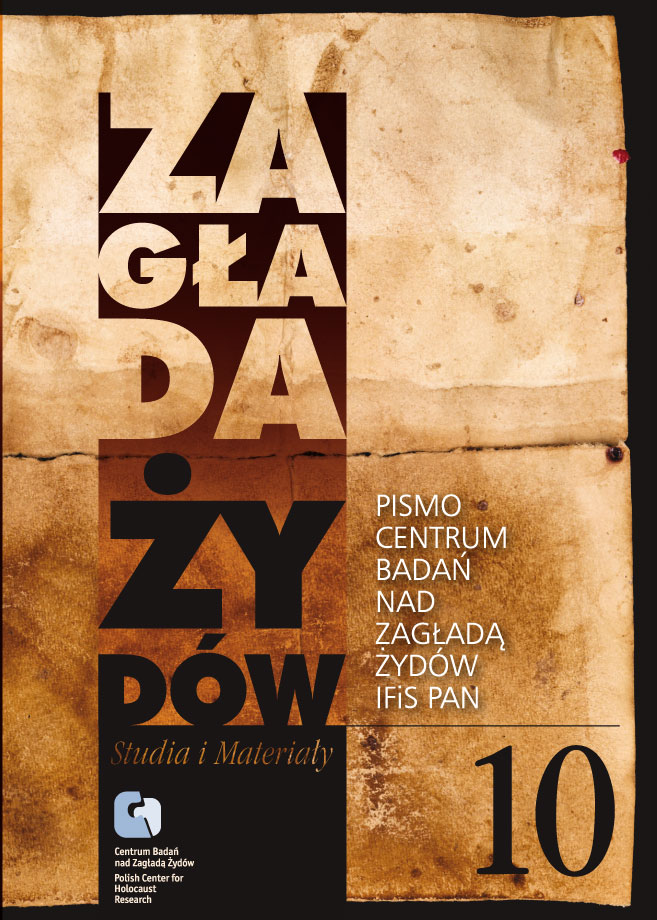Krzesiny i Kreising – między pamiętaniem a pomijaniem. Polskie miasteczko wobec historii, pamięci i rywalizacji w cierpieniu
Zagłada Żydów. Studia i Materiały, Nr 10 (2014), Strony: 443-461
Data zgłoszenia: 2020-10-22Data publikacji: 2014-12-01
 https://doi.org/10.32927/ZZSiM.532
https://doi.org/10.32927/ZZSiM.532
Abstrakt
The area around Krzesiny, located near the city of Poznań, Poland, witnessed several dark events during World War II: Germans oppressed the local population, culminating in a terrorizing action dubbed “akcja krzesińska;” also, a forced labor camp, named “Kreising,” was built near the township, housing mainly Jews. After the war, the suffering in Krzesiny was remembered, but selectively – “akcja” and other forms of Polish suffering were commemorated, while the camp was not. By exploring the “lieux de mémoire” in Krzesiny – dynamics of memory in a small township in Poland – this paper uses localized research to address the issue of gaps in collective memory and commemoration. We briefly look at the relevant history, Polish memory regarding wartime events in Krzesiny, and the postwar dynamics of collective memory. Discussing the latter, we identify a new phenomenon at work, one which we dub “collective disregard” – group neglect of the past of the “Other” that occurs without clear intent. We argue that “collective disregard” is an issue that naturally occurs in the dynamics of memory. By making a deliberate investment in balanced remembrance and commemoration, societies can counter the tendencies of “disregard” and curb the controversies of competitive victimization claims, also called “competitive martyrdom”.
Licencja
Prawa autorskie (c) 2014 Autor & "Zagłada Żydów. Studia i Materiały"

Utwór dostępny jest na licencji Creative Commons Uznanie autorstwa 4.0 Międzynarodowe.
https://creativecommons.org/licenses/by/4.0
Podobne artykuły
- Zofia Wóycicka, Laboratorium zagłady – nowa ekspozycja historyczna na terenie obozu zagłady Kulmhof w Chełmnie nad Nerem , Zagłada Żydów. Studia i Materiały: Nr 16 (2020)
- Marcin Kula, Elementy obrazu może błędne, ale całość najpewniej prawdziwa. Jedwabne, Radziłów, Wąsosz… [Mirosław Tryczyk, Miasta śmierci] , Zagłada Żydów. Studia i Materiały: Nr 17 (2021)
- Redakcja, Od Redakcji , Zagłada Żydów. Studia i Materiały: Nr 13 (2017)
- Jan Borowicz, Co widać zaraz po wojnie? Zapomniane obrazy Zagłady z lat czterdziestych , Zagłada Żydów. Studia i Materiały: Nr 17 (2021)
- Jan Borowicz, Bożena Keff, Strażnicy fatum , Zagłada Żydów. Studia i Materiały: Nr 16 (2020)
- Marta Janczewska, O śmierci w niemieckim języku oficjalnym na przykładzie raportu Jürgena Stroopa , Zagłada Żydów. Studia i Materiały: Nr 12 (2016)
- Marcin Kula, Szuflada z dokumentami [Czarna księga, red. Wasilij Grossman, Ilja Erenburg, oprac. Joanna Nalewajko-Kulikov] , Zagłada Żydów. Studia i Materiały: Nr 17 (2021)
- Jakub Chmielewski, Postawy Polaków wobec Żydów w świetle okupacyjnych dokumentów na przykładzie dystryktu lubelskiego , Zagłada Żydów. Studia i Materiały: Nr 20 (2024)
- Małgorzata Pakier, Prehistoria pamięci. Zagłada we wczesnym amerykańskim programie rozrywkowym , Zagłada Żydów. Studia i Materiały: Nr 7 (2011)
- Justyna Kowalska-Leder, Fetyszyzacja autentyczności – casus muzeum-miejsca pamięci , Zagłada Żydów. Studia i Materiały: Nr 17 (2021)
<< < 1 2 3 4 5 6 7 8 9 10 11 12 13 14 15 16 17 18 19 20 21 22 23 24 25 26 27 28 29 30 31 32 > >>
Możesz również Rozpocznij zaawansowane wyszukiwanie podobieństw dla tego artykułu.
 English
English
 Język Polski
Język Polski








